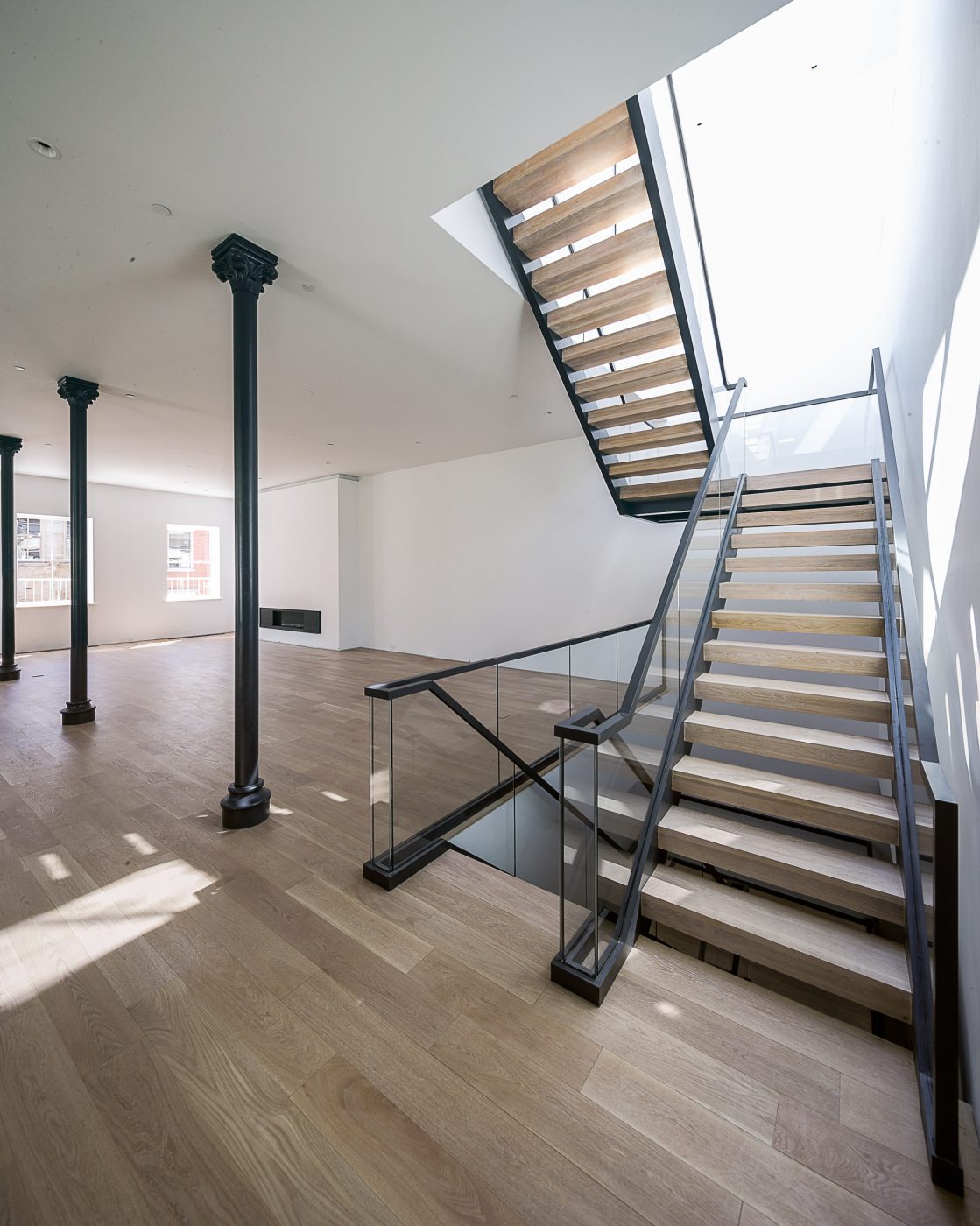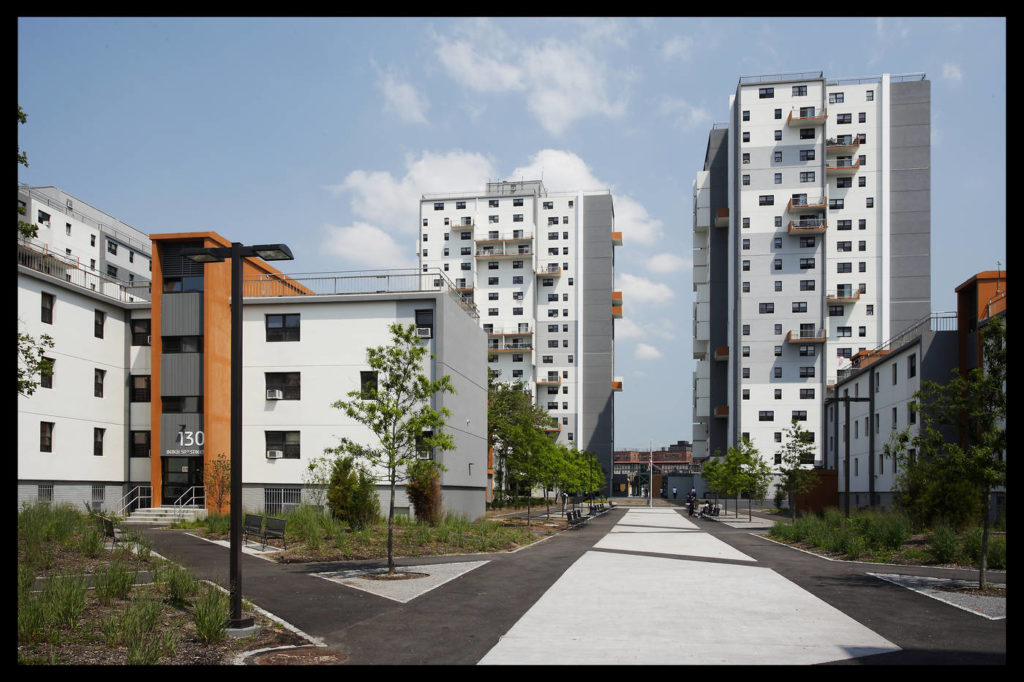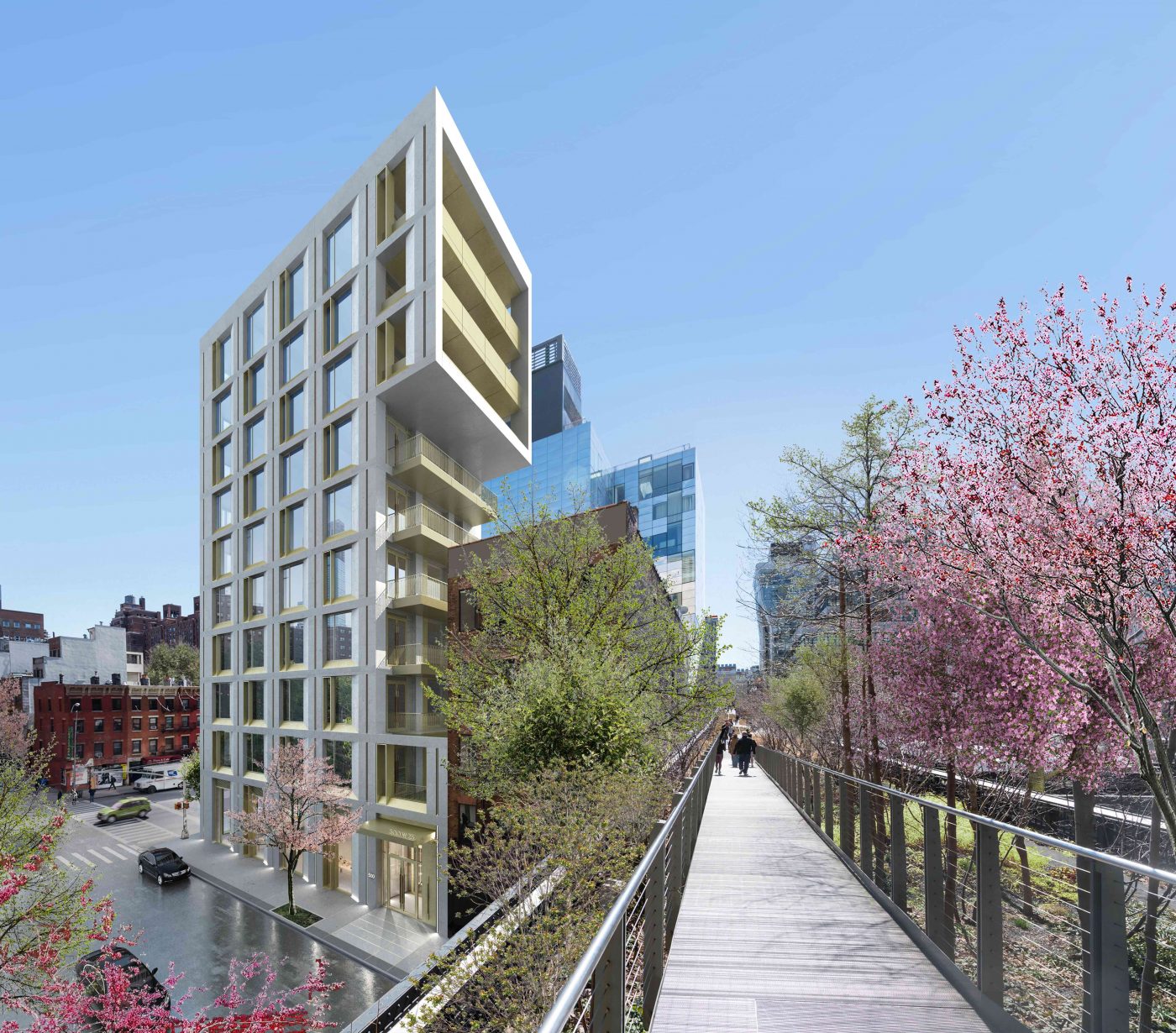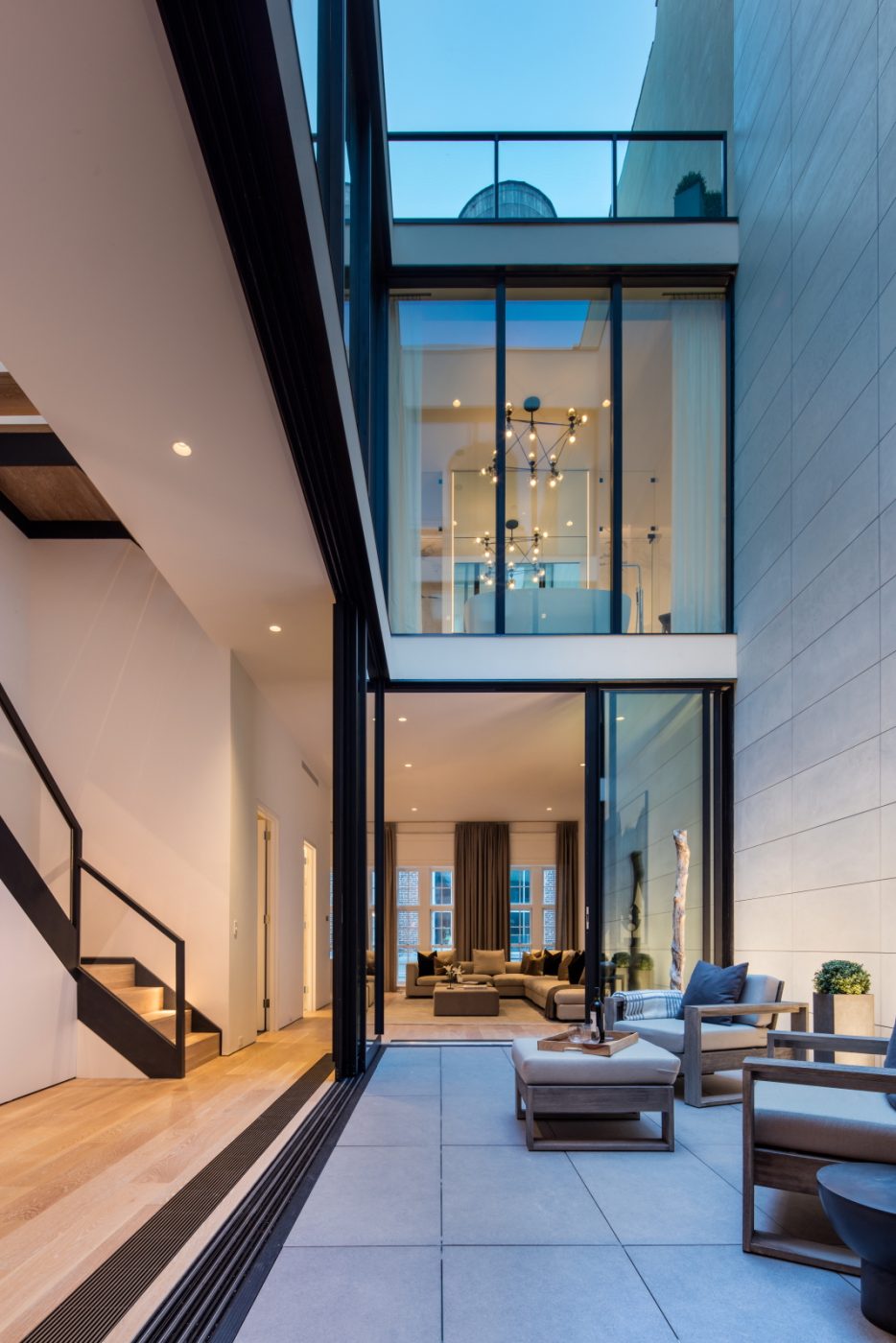Interview: Michael Kirchmann of GDSNY

In summer 2019, I spoke with Architect & Developer Michael Kirchmann of GDSNY from New York, NY. See more information about GDSNY at gdsny.com. See more articles about Michael {here}.
Michael Kirchmann: My father was a contractor and real estate developer and my mother was an interior designer – so I grew up surrounded by art, architecture, design and real estate.. Growing up I spent a lot of time on building sites and in my father’s office. During summer holidays I would work in the offices of one of the architects he was employing. This was back when we did things the old-fashioned way with yellow tracing film and ammonia prints. But it gave me the bug. In South Africa, you go directly from high school to architecture school. What I like about the American system is that you do more general undergraduate studies, and then you specialize, whereas in South Africa, it is a seven-year architecture program with a narrow focus. You can’t steer too far from that particular course. When I was at the University of Cape Town, I already had an interest in development. You weren’t supposed to veer from the architectural program, but I actually completed a certificate in real estate development.
Right after graduating, I left South Africa for New York City. I had wanted to become a real estate developer but ended up getting a job offer from Skidmore, Owings & Merrill, and ended up spending more than 10 years there. That was a very interesting and fortuitous route. Shortly after I started at SOM, David Childs and Roger Duffy came to me. We had this great client in the 1990s who was taking the class A specification that he was building in New York and adapting that sophistication and that approach to Europe. His name was Howard Ronson. He was one of the biggest developers in New York City at the time. So off I go as a young architect to Paris. Howard, Roger Duffy, AlanRudikoff, and I sitting around the table and planning office developments in Europe. Over the course of the next ten years we built 23 class A office buildings, all around 700,000 to a million square feet each, in the UK, France, and Germany.
It was during this time that I realized that I had a penchant for development. Even though I was the architect at the table, I always had a genetic predisposition to both design and development. I very quickly was able to adapt to Howard’s language and was super interested from day one in the development side. Howard was a wealth of knowledge. Eventually, that table of four people grew into about 40 people. This relationship with Howard was really formative for me – that experience of working for SOM and working directly with a client of his caliber and also getting to work with the best consultants in the world was the best education.

MK: And so then in 2007, I woke up one day and thought about how I had worked for SOM for ten years and I was supposed to come over [to the United States] to become a real estate developer. Coincidentally at that time, somebody from NYU had invited me to present some lectures in their real estate masters program, which I really enjoyed. I saw the rest of the curriculum for the course and it had a lot to do with finance, which I was very interested in.
As much as we as architects love to convince ourselves that design plays a pivotal role in development, the reality is that development is a finance game. That’s why so many people in banking get into real estate development. You have some secret weapons if you come from the design side. But the truth of moving from architecture to development is that this is a finance game. First and foremost, it’s about debt, structure in a capital stack, the waterfall, where and how you make those returns, all that kind of stuff is paramount to even getting to the point of putting design pen to the page.
So, I saw what the students were doing at NYU and I said, “I need to do this too.” I was still teaching but became a student too. I finished my Masters in Real Estate in 2008, and by then I had started the company, GDSNY. At the same time, I had done some lectures at Harvard and the Architectural Association in London, and around 2010 I got an invitation from Columbia to teach in their Master of Science in Real Estate program. Columbia is a very special place; the campus is just so perfect and the architecture school so impressive. I taught with Chris Cooper, who is now a partner at SOM. Chris and I ended up actually teaching that program for five years. That was a really fun thing where we were able to teach design within the development capsule.
James Petty: I feel like academia is a great pathway to starting a business and offsetting some of your own life expenses. I know there have been a number of prominent firms where the founders spent a bit of time teaching in those early years when money was tight. It helps ease the transition of being an employee of a firm to your own independence.
MK: Yeah, but it was also a way to surround yourself with an interesting and active bunch of people. The faculty were great and it was a great environment to exchange ideas and discussions.
So in 2007, we started the company with the intended purpose of being a developer. From the tail end of 2007 and going into 2008, we started looking for development deals. It didn’t take us very long to realize that 2008 was not the best time to be in development. One of the things I did when I left SOM was to make a commitment to myself to not poach any SOM clients. At the same time, there were some new relationships that I built that led to new projects, such as the Bahrain International Airport and 540 W28th Street. So luckily, we were able to fall back on to our original core competency, which is design. From 2008 to 2010, we actually ran a very successful architecture firm. We opened up an office in London and did a couple of towers in London, and a lot of really good stuff in the Middle East. For all intents and purposes, it was a good business, which we still keep today. We still have the architecture business.
JP: Where you work as an architect for a client?
MK: Yeah. We don’t do it much anymore, but we do have a few legacy clients whom we love. A good example of that is our low-income housing guys, L+M Development. Being involved in these projects is very important to me, because otherwise, we’re doing a lot of high-end condos and high-end boutique office buildings. It’s just a great counterpoint for us. We’ve designed and built around 4,000 affordable housing units.
We designed a project called Arverne View in the Far Rockaways. L+M closed the day after Hurricane Sandy. That project is on the beach and it was just destroyed, but they signed it anyway. We produced drawings very quickly, as time was very short and construction had to start almost immediately. It was remarkable to see how quickly and powerfully their company can operate. From there, we’ve done probably a dozen buildings with them. It has been a great relationship.

MK: Jump forward to where we are now. If you look through our work, we also like to have fun with design. We’re big automotive junkies, so we like to do some sort of car or motorcycle project from time to time. We like to do industrial design projects. We’ve done skateboards and surfboards. We’ve done some very big art pieces in New York and in London. This is where being trained as an architect and having an interest in design really influences the development work. We’re trying to overlap this idea that as designers, our developments are also influenced by a certain lifestyle. When you are a tenant or a purchaser of one of our properties, you become part of that design ethos. It brings a level of cool and keeps the interest high.
We learn a lot of things from doing smaller design projects. For example, we just completed designing and building a custom Land Rover Defender 90. We spent a lot of time customizing the seats with different types of stitching, and now those stitch patterns are appearing in our lobbies and VIP areas. We recently did a mini-documentary about the recent concrete pour at 1245 Broadway. Exploring all these mediums just makes the job fun as well.
JP: Absolutely.
MK: That’s why when you look at our website, you might wonder what we’re doing with art and design. We really are first and foremost design-led developers. That is what we hope differentiates us from the others who are out there in the industry. We aren’t the only ones though; there are others clearly led by design, such as Alloy, Cary Tamarkin, DDG.
JP: Those are some of the larger players doing big work now in New York. Did you say that you started GDSNY as a development company?
MK: Yes.
JP: When you decided to start your own company, was it supposed to be a design-led development company?
MK: Always. Going back to the Howard Ronson days, we were participating by putting our design ideas on the table. He was participating by putting his development ideas on the table. I’m pretty sure he didn’t learn much from us. He already knew everything. But we learned a lot.
JP: That is a great opportunity.

MK: So going back to that table that we used to sit around in the 1990’s in Howard’s apartment. The other guy that was sitting next to Howard on his right-hand side was a guy named Alan Rudikoff.
JP: Who is now your partner.
MK: Yes. Alan was the guy who did all the finance and structuring. He did debt structuring, equity structuring, all of the financial modeling, that whole side of the business. He and I were the same age and over the course of many years, we kept in contact. He is a very successful developer and we just kept working together. In 2012, he moved back to the US from Sweden where he was living and working. He wanted to be back in New York. We thought this was the opportunity that we had been talking about for the previous 10 years and decided to do it.
By then I had already completed and sold 177 Franklin Street, our first office development in NYC. So Alan came over and we started looking at different platforms and various asset types. The project at 25-27 Mercer Street was the first one set up on this new platform that we started together.
JP: Those are condos, right?
MK: Yes. It was a great project for us.
JP: Is that when GDSNY took off?
MK: That put us into second gear. What kicked us off was 177 Franklin. 25 Mercer sold very well.
JP: Do you have your own in-house brokerage?
MK: No. I know some of the other companies do brokerage.
JP: I know DDG and Alloy do. I think most people are timid to do their own brokerage.
MK: We don’t do our own construction either. We hire general contractors. I just think that you have to know your own strengths and interests and there are aspects of this business that are better suited for someone else.
JP: I think a lot of architects see the broker’s fees and start to make assumptions about how little work is involved in that fee. They feel they are already making better marketing materials and selling the building to a client, why not try and sell it on the market and make those fees? I think when a lot of them actually get into it, they realize it actually is a real job that requires a lot of effort.
MK: We work with the best brokers and have great relationships. They have the infrastructure and the connections. They can pick up the phone and connect to real buyers. I think it’s futile to try and compete with that. It’s not about the marketing materials, as much as it is about buyer and leasing connections.
JP: What about acquisitions? How do you go about finding properties?
MK: We have an acquisition team in-house. They approach owners directly. We also have a great relationship with brokerage houses in the city. Our in-house team looks at nearly 200 properties per year.
JP: So they are constantly vetting through properties and looking for opportunities?
MK: Yes. If we are looking at 200 properties per year, we may be signing on two. It’s a hard slog. What is nice about it is that we keep a very careful database of all the properties. So very often we will look again at a project we looked at 10 years prior. We can go back and look up the drawings, photographs and pro formas. We keep everything well categorized. Our database has become very valuable to us because of that.
JP: It seems like a lot of the bigger actors in development around New York City are creating their own databases and sometimes even their own software explicitly for acquisition. It is one of the most important aspects of development. A lot of the money is made in the buy.
MK: All of it.
JP: If you fuck up there, there is really no way out.
MK: Exactly.

JP: With 1245 Broadway, why did you hire SOM to be the architect? Was it capacity within GDSNY?
MK: There were several reasons. SOM is one of the leading commercial architecture firms in the world. There’s a cachet to be coopted and cleverly incorporated into the projects. A part of it is my relationship with the firm. It is very strong and something that I value. You want to work with brilliant people, but you also want to work with people that you want to work with. On the investment side, sometimes it is actually easier to take a step to the side, and keep an arm’s length transaction by getting a third-party architect. That way there is no question who is the developer. A bank might say, “you’re getting a fee on this, and you’re getting a fee on that. Are you getting too much fee?” It does make things a lot cleaner from the structuring standpoint to have a separate architect. As we have grown, I still personally get very involved with the design. At this point, there are only so many hours in the day. I am still very involved in the decisions. It is always a close collaboration.
We are doing 1245 Broadway, 322 7th Avenue, aka 28&7, and we’re also now doing 118 10th Avenue. We just bought the Park Restaurant on 10th Avenue. We’re kind of between the Highline, the new Heatherwick project, and the Bjarke Ingels Project. Our project there is going to be really exciting. We’re in design right now. All total, we are building around a million square feet right now.
JP: With that amount of area you really need another firm that can take these on and produce the drawings.
MK: Especially in New York City where there are so many agencies involved. That is another reason we work with other architects as well.
JP: But you still want to continue designing?

MK: Oh yeah. We still continue to design. We just completed Dogpound LA, a gym project out there. We have a new car design coming out as well. We are still working with L+M Development and doing a few affordable and mixed-income projects with them. We are the design architects on our development at 500 W25th Street.
JP: That one is well under construction, right?
MK: Yes, it is almost completed. We have a model apartment that is opening at the end of October. It is going to be a beautiful project.
JP: I can only imagine some of their employees thinking, “I have to work for an architect now?” That sounds scary.
MK: One of the constant struggles with being an architect and a developer is that you want to make great buildings, but you have to constantly fight with the budget.
JP: There is a very real financial restraint that you actually have a position in.
MK: It is a lot like having two angels on your shoulder. “Just do the cantilever!” “Forget about those columns!”
JP: It’s easy.
MK: Ha!
JP: How does GDSNY finance the projects under development? Is it through private investment, bank loans, a mix?
MK: Some projects have a more traditional structure where we have equity and bring in some LP’s [Limited Partners] and then get bank debt.
JP: A construction loan?
MK: Exactly. Typically, you have a GP [Genereal Partner], LP, and debt.
JP: Are you always on the lookout for new partners either for current or future projects?
MK: We’re always looking for good partners. Having great partners is paramount to a successful development. It is kind of similar to when you are an architect, the most important thing you can have is a good client. As a developer, the most important thing you can have is a great capital stack. The reason I say capital stack is because debt falls into a certain category. You can have great debt providers, and you can have not so great debt providers.
JP: Are all of your residential projects condos that you sell, or have you developed rental units to hold for passive income?
MK: We have one for-sale condo project currently, which is 500 W25th Street. All of our other current projects are commercial office buildings that we will keep long term.
JP: That is definitely different than what most Architect & Developers are working on. Most of the others seem to focus strictly on residential development. You seem a lot more comfortable doing both.
MK: Sure. Both my and Alan’s experience has been predominantly commercial office. We have done some residential. I think there is definitely a healthy balance between residential and office. It is a good diversification. It is not that easy to do, because generally, architects and developers specialize in one or the other.
JP: How do you fund the architecture side of your business? These costs are generally seen upfront before you can capitalize on the development. Are you taking fees from financing or cash flowing this as you go along?
MK: Before or after we sign a deal?
JP: Before.
MK: Well basically that is our underwriting costs. We have to bear those costs ourselves. We hope to make up those costs. I was talking earlier about the 200 deals where we sign two. Factored into those calculations is the money that we need to try and recoup on the other 198. That is part of the risk that we take on as an underwriter.
JP: Some Architects & Developers will factor in their architecture fee to fund the practice. Others will use that as an equity position in a deal.
MK: It depends on who your debt provider is. Some have a problem with it but most of them don’t. As far as they’re concerned, it is a project cost. Whether you’re doing the architecture or somebody else is doing it, it is a consultant cost that needs to be paid. Somebody has to do that work.
JP: You mentioned that you have found some financial institutions start to question your business model of being the architect for your own developments.
MK: It wasn’t an issue on 500 W25th Street as we paid our own architectural costs. Generally speaking, you would include that as part of a deal. Let’s say something goes wrong and the bank has to foreclose on the property. There still needs to be some kind of budget in there for another architect to come in and complete the project.

JP: Do you feel like a business background or education is necessary for developing as an architect? Do you feel like a degree or certificate is beneficial?
MK: Yes. University provides you a vocabulary. It doesn’t really provide you with experience. When you come out of your studies, you come out with a vocabulary that enables you to conduct a serious conversation in your field. From there you can learn the craft. That is kind of a long way of saying you’re definitely going to save yourself a lot of time by giving yourself an intensified course at a college of some sort. But it’s not an absolute prerequisite. If you are able to get a job at a development company with whatever qualifications you have, you can definitely get back into that role. Chances are that as an architect, those entry points are in the management side. A lot of the time, depending on the size of the firm, that project management side will be somewhat divorced from the financial side.
JP: I have a lot of friends that were educated as an architect and went to work for a development company. Many of them are not exactly doing what they were hoping they might be doing in their daily tasks.
MK: NYU and Columbia compete with one another. Students have asked me over the years which one they should go to. Which one is better? My answer to that is always; if you come from a design background, go to NYU. NYU has a very strong financial program. That’s what I did. If you come from a banking background, and your deficiency is design or implementation, then I would recommend you go to Columbia.
JP: You recommend that they focus on learning what they aren’t already skilled at?
MK: It is asking yourself the question, “where are my deficiencies?” and then trying to fix them.
JP: Do you think partnering with someone who has had a focus on those deficiencies is critical to a successful practice? I think about Jared Della Valle at Alloy and Peter Guthrie at DDG. They each partnered with someone who had that experience in finance where they were perhaps a little deficient.
MK: In my particular instance, are you talking about my partner Alan?
JP: Yes.
MK: What is so great about our partnership is that we are both skilled at what we do. Together we form two very strong bookends. And together that is everything we need to do this job. There are things that he can do better than me and vice versa. But there is a very strong overlap in our knowledge base. He will always have the ability to do what I do to a certain extent. Likewise, I am comfortable with the financial side also. But he has exceptional proficiency in that. Bringing these two things together in a partnership is like a marriage. Finding the right partner, whether it is in business or in life, is paramount. One very important thing that I learned from Howard Ronson is that over the course of his 40 plus year career, he was able to understand every single aspect of development. We would go from a lawyers meeting, to a bank meeting, to a MEP meeting, to a dewatering meeting. He would have complete knowledge of all these disciplines to where nobody could pull one over on him. That has been a very clear goal of mine as well, to know every aspect of development and the process. That is why I wanted to do an NYU course. I recognized my deficiency on the financial side. That was a very important step.

JP: If you could go back, is there anything that you would have done differently?
MK: I don’t think there is anything I would have done differently. I think one thing I have learned is the importance of your network of investors and your network of debt. That is a key component.
JP: It is all about relationships.
MK: I was extremely fortunate to have had the opportunity to work for SOM all those years. I was extremely fortunate to have had the opportunity to work so closely with Howard. I was extremely fortunate to partner with Alan. At every stage, there has been something formative that has happened. It is hard to have regrets when you look at it like that.
JP: How big is your office now?
MK: We are about 20 people.
JP: How many of those people are architects versus employees from other backgrounds such as business?
MK: It is probably a third architects, a third business, and a third operations.
JP: For the architects that you hire, do they have backgrounds in real estate education such as the Real Estate Development Program at GSAPP? Are the architects interested in what you are doing beyond a design level?
MK: Sure. But we love to visualize our projects. We use a lot of in-house modeling and visualization. So that takes a certain kind of skill. Obviously, experience in the field. For the most part, operating in New York is a very complicated ecosystem of city agencies, neighbors, etc. Neighbors are a big part of development.
JP: Do you have any words of wisdom for younger folks still in college or just getting out on getting to your level of what you’re doing? Obviously, there are a million paths people can take in life.
MK: This is a difficult path to take, but I think exploring multiple paths at the same time can bring you to a point that you’re naturally meant to go towards. What I mean by that is if you’re an architect that is interested in graphic design, and you’re also interested in development or whatever else… you know there’s a limited number of hours in a day. People work nine to five, they get out, go home and watch TV, or go get a drink, or do whatever. You can spend a lot of those hours doing other things. You can have three jobs at one time. It sounds like a lot of work, which it is. By running three parallel paths and basically running multiple jobs, you’re educating yourself and putting yourself in multiple environments with more people and contacts. Suddenly those things start to merge. They come together. Unfortunately, there is no shortcut. It’s hard work. That is one way. You get one shot in life. There is a time limit to your valuable years as a productive professional. In my experience, the way we get to a point where everything comes together is to run multiple interests at one time and to watch as those interests merge together into something incredible.
For more on Michael Kirchmann, see the book Architect & Developer: A Guide to Self-Initiating Projects. See more articles about GDSNY {here}.